Will We Shelter in Place Again
1. Introduction
The global pandemic of COVID-xix afflicted countries and communities effectually the earth with detrimental impacts on population health besides every bit economies. The tragic examples from countries such as Italy and Spain showed the importance of flatting the curve as sudden surges in hospitalization can easily strain fifty-fifty the well-operation healthcare systems (1, 2). COVID-19 is thought to spread mainly through close contact from person-to-person1. Therefore, policymakers tried to control the spread of the illness and reduce the burden on the healthcare system by policies that encourage and sometimes strength social distancing2. In the Usa, the state-broad shelter-in-identify policies are the almost common of such policies. Shelter-in-place orders (SIPO) require residents to remain dwelling for all simply essential activities such every bit purchasing food or medicine, caring for others, exercise, or traveling for employment accounted essential. Between March 19 and April 20, 2020, 40 states and the Commune of Columbia adopted SIPOs (3).
A fast-growing body of literature explores the potential impacts of stay-calm orders on various indicators from the COVID-19 hospitalizations, cases, and fatalities to their implications for mental health (4, v), physical health (half dozen, 7), and domestic violence (eight–10). Some studies observe that stay-at-home orders are associated with a slower growth rate of hospitalization (11, 12). Closer to our study are the ones that focus on COVID cases and deaths. (13) analyzes the US data from March i, 2020, to April 27, 2020, and notice that adoption of government-imposed social distancing measures reduced the daily growth rate past 5.4 percentage points after 1–5 days, 6.eight later on 6–x days, 8.two after eleven–15 days, and 9.ane afterwards 16–20 days. Similarly, (3) work with information from all the states from March 8, 2020, to Apr 17, 2020. Using daily land-level social distancing information from SafeGraph and a difference-in-differences arroyo, they find that adoption of a shelter-in-place order (SIPO) is associated with a v–10% increment in the rate at which state residents remained in their homes full-fourth dimension. Also, using daily land-level coronavirus case data nerveless past the CDC, they find that approximately 3 weeks following the adoption of a SIPO, cumulative COVID-19 cases cruel by 44%. Similar to our newspaper, (14) focus on a item state, namely California, to approximate the touch of the state-wide SIPO on the COVID-19 cases and deaths.
Nosotros focus on a large land, Texas. Our data span almost 4 months, which allows united states of america to see better the evolution of the pandemic during as well as after the expiry of the SIPO. The fact that Texas is one of the relatively early on states to start the reopening and experiences a mail service-opening surge in the number of cases makes it an interesting case to study closely. We apply daily data from March 1, 2020 to June 27, 2020, to report the development of the COVID-19 pandemic in 254 Texas counties. We analyze the impact of the statewide shelter-in-identify order issued on April 2, 2020, on the measures of social distancing, and consequently, on the COVID-nineteen cases and deaths.
two. Materials and Methods
2.one. Data
The data for this study comes from the Unfolded Studio website (https://covid19.unfolded.ai/). The website compiles data from diverse sources. The COVID-19 cases and fatalities data are from the New York Timesthree. Social distancing measures are from SafeGraphfour. County-level population data are from the US Census. SafeGraph's social distancing data are generated using a panel of GPS pings from bearding mobile devices. The data determine the mutual nighttime location of each device and telephone call that location "domicile" (approximately a 153 by 153 one thousand expanse). The shelter-in-identify percent reported in the Unfolded information shows the percent of the population who stayed at home on a mean solar day. Finally, we apply the National Association of Counties' (NACo) county explorer to get county-level COVID 19 related policy responses. Our dataset is daily and at the county level.
2.2. Methods
2.2.i. Theoretical Background
We provide a basic description of the theoretical foundations for the spread of the disease. Although the model of a pandemic is not strictly exponential, the exponential growth model may provide a good approximation at the beginning of the pandemic and is implicitly used in much of the literature.
The discrete-time version of the exponential growth model is described by the equation5:
where c t denotes the total number of cases at time t, δ represents the growth charge per unit, and c 0 is the number of cases at time nil. The parameter of interest is δ, the rate of growth of the procedure, which tin exist interpreted equally the number of infected individuals by one infected individual in a day. Rearranging Equation (ane), we tin write
Given a sample {c t } of observations, we are interested in estimating the growth charge per unit and the effect of a policy variable (T t ) on the growth rate. This can be done past estimating the equation
where
where y t is the growth rate, βane is the estimated growth rate before the policy, and βane + α1 represents the growth rate after the policy, with α1 being the effect of the policy.
The model we nowadays provides a good approximation for the development of the number of cases. Fatalities, even so, are much harder to model. Similar to cases, we analyze the growth rate of deaths to provide a complete picture. However, we are aware of the problems associated with fitting the same type of model for cases and fatalities. Get-go, social distancing may take dissimilar furnishings on the growth of cases and deaths. In particular, social distancing measures are more probable to show a bigger and faster impact on the spread of the illness than the number (or growth rate) of fatalities. In addition, as medical researchers learn more about the disease, they will exist able to reduce fatality rates, presumably, long earlier they find a definitive cure to completely eradicate it. Even though the disease keeps spreading, we may run across lower rates of fatalities. This may even happen without any exterior intervention if the virus evolves and becomes less fatal.
The assay of the furnishings of the shelter-in-place order on social distancing and the number of cases and deaths was conducted at the country level and at the county level.
2.2.2. State-Level Analysis
For the country-level assay, we aggregated the canton data by summing up the daily values for all counties to get the state-level time series data. To guess the effects of the SIPO, we dissever the SIPO menses into 4 weekly subperiods since we expect the SIPO to have a gradual touch on on the spread of disease6. We estimate the following empirical model:
where y t is either the growth rate of cases and fatalities, or the measure of social distancing. SIPO0 is the week the gild was enacted, SIPO1 is the second, SIPO2 is the third week, and SIPO3 is the quaternary and the last week that the policy was in effect. The model also includes a linear daily time tendency. In addition, nosotros approximate the effects of the SIPO on the growth charge per unit of cases and fatalities controlling for social distancing to determine whether the policy had whatever effects other than its issue through social distancing.
2.2.3. County-Level Analysis
The country-level analysis indicates that the SIPO reduced the spread of the disease through its event on social distancing (the per centum of the population sheltering in identify). Therefore, we apply the county-level analysis to further investigate the effect of the statewide SIPO on social distancing, while controlling for local policies.
First, we investigate the effect of the statewide SIPO on the larger counties which implemented local policies before the statewide SIPO (Harris, Dallas, Tarrant, Bexar, or Travis). In each of these counties, outset, a public health emergency is declared, which is so followed by a local stay-at-home order, and this is later followed past the country-wide shelter-in-place order. We assume each policy replaces the former. For the analysis, we estimated the following equation:
where y i,t is the sheltering percentages in county i on day t and X i,t includes the county-level policies (local emergency or local shelter-in-place guild). In addition, nosotros control for a daily fourth dimension trend and county fixed furnishings. The regressions are weighted by county-population and the standard errors are amassed at the county-level.
Next, we investigate the outcome of the statewide SIPO on the counties that never had any type of local canton-level policy. If the statewide SIPO is effective in increasing the pct of the population that stays at home, 1 would expect counties without any restrictive local policies to grab up with other counties once the state-broad coating policy is imposed. Therefore, we estimated the post-obit equation including all the counties in the land:
where y i,t is the sheltering percentages in canton i on twenty-four hours t. The key variable, NoPolicy, is a dummy that takes the value of one if the county did non have any local policy prior to the statewide SIPO. We include day and county fixed-effects. The regressions are weighted by county population and the standard errors are clustered at the county-level.
3. Results
iii.one. State-Level Results
Effigy 1 shows the full cases and fatalities by day in Texas as well as the growth rates of those. We estimate Equation (5) for the growth rate of cases and fatalities. The results in Table 1 testify that the growth rates of cases are 0.07–0.084 points lower during the SIPO period. Given that the mean growth charge per unit of cases is almost 0.1 outside the period, these numbers imply large drops in the growth rates of cases during the period. Similarly, the growth rate of deaths is 0.105–0.131 points lower during the SIPO, the largest decreases happening in the third week of the policy.
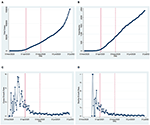
Figure 1. COVID-19 cases and fatalities in Texas. (A) Cumulative cases. (B) Cumulative fatalities. (C) Daily cases growth. (D) Daily fatalities growth. This effigy shows the cumulative cases and fatalities, besides equally their growth rates over the time in Texas. The solid and dashed vertical lines show the outset (April two, 2020) and the stop of the land-wide shelter-in-place lodge (May 1, 2020).
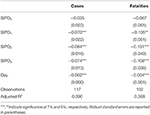
Table i. The growth of COVID-19 cases and fatalities.
Nosotros also clarify the impact of the policy on social distancing measures. In particular, we look at the pct of population sheltering in identify created by SafeGraph. Effigy 2 shows the percentage of the population that shelters in place. Table 2 reports the regression results we go from estimating Equation (five) for the sheltering percentages7. Both the tabular array and figure betoken the percentage of the population that shelters in identify is, on average, higher during the SIPO period. The highest rate of sheltering corresponds to the commencement week of the SIPO, and the sheltering pct gradually goes down fifty-fifty when the SIPO was still in result. Compared to the sheltering percentage exterior the policy period (25%), the share of sheltering population is most nine–41% college during the SIPO period.

Figure 2. Sheltering population. (A) Sheltering %. (B) Sheltering % weighted by population. This figure shows the average percentage of the population that stays at dwelling house in Texas over time. The solid and dashed vertical lines show the beginning (April 2, 2020) and the cease of the statewide shelter-in-identify order (May 1, 2020). For the correct panel, the counties' sheltering percentages are weighted by the counties' populations, then aggregated at the country level.
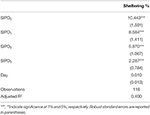
Tabular array two. Sheltering population and the SIPO.
Table three shows the affect of the SIPO on the growth of cases and fatalities when we control for lagged sheltering percentages. Considering of the nature of the illness, social distancing measures show impact just after a while. We estimate Equation (5) using the 14-24-hour interval lagged sheltering percentages in add-on to the SIPO indicators and time trends8. The table reveals that the SIPO dummies are statistically insignificant once the sheltering population is controlled for. These results propose the SIPO may slow down the spread of the affliction through its effect on the per centum of people sheltering in place. The policy itself is not meaning once we control for this percentage.
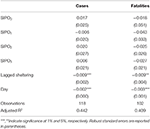
Tabular array three. The growth rates controlling for lagged sheltering percentages.
The state-level assay shows one thing is clear: Social distancing slows downwardly the growth of casesnine. The important question remaining is whether the country-broad SIPO had a causal touch on social distancing every bit measured by shelter-in-identify percentages. We address this question in the next section.
three.2. County-Level Results
Figure two shows that the shelter-in-place percentages started to increase well before the state-level SIPO order. According to NACo, many counties adopted local policies such as public health emergency and safer-at-home declarations days or weeks before the country-wide policy. Overall, lxx counties in Texas have at least one type of policy, emergency or county-level shelter-in-place order, while 30 have both. The adoption of these policies is unlikely to be random. In particular, the size of the population and the number of cases are positively correlated with the likelihood of restrictive policies. This is particularly truthful for county-level stay-at-home orders. Several counties declared a health emergency early on when the cases were few. As the cases went up, the counties with higher numbers of cases adopted shelter-in-place orders.
We take a close look at the county-level trends in the virtually populated 5 counties: Harris, Dallas, Tarrant, Bexar, and Travis. These span the majority of the four biggest cities in Texas: Houston (Harris), Dallas (Dallas and Tarrant), San Antonio (Bexar), and Austin (Travis). These v counties make nigh 44% of the full Texas population, while the remaining 249 counties make up the rest. Perhaps non surprisingly, the earliest COVID-19 cases emerged in these five counties. And, all of these counties ordered a county-level stay-at-home policy before the land-wide SIPO. They also alleged a county-wide emergency fifty-fifty earlier the sheltering policies10.
Figure 3 shows the percentage of the populations sheltering in place in each of these counties. Table 4 shows the results from estimating Equation (half dozen). The results reveal that the initial pronounced increase in sheltering percentages corresponds to the announcement of county-wide emergency and shelter-in-place orders.
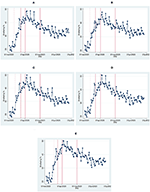
Figure 3. Sheltering percentages in Texas counties. (A) Harris. (B) Dallas. (C) Tarrant. (D) Bexar. (E) Travis. This figure shows the percentage of the population that stays at home in the five about populated counties of Texas over time. The dotted line shows the emergency declaration date, the dashed line shows the canton-wide SIPO, the solid lines mark the beginning and the stop of the statewide SIPO.
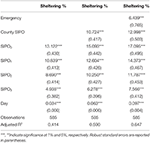
Tabular array 4. Sheltering percentages in almost-populated Texas counties.
Next, we have a look at the counties that never had any blazon of county-level policy. Figure 4 shows that at that place is a significant difference in terms of sheltering population in the biggest 5 counties vs. counties that never adopted any type of policy prior to the state-wide SIPO. The panel that shows the trends before the state SIPO reveals that in both groups of counties, the sheltering percentage increases over time. However, the gap widens over fourth dimension. Interestingly, even after the implementation of the land SIPO, the gap persisted. The policy did not disproportionately affect the counties with no prior policies. Likewise, the gap carries on later the SIPO expires. The figure suggests that more people shelter in highly populated areas. This may still be a reflection of the fact that the perceived risk of catching the disease is higher in those areas, and the impact of fear is strong enough to keep more than people at dwelling house.

Figure 4. Sheltering percentages. (A) Before SIPO. (B) Whole period. The figure shows the average sheltering percentages in ii groups of counties: The almost populated five (Harris, Dallas, Tarrant, Bexar, and Travis) and the counties that never adopted whatever county-level policy. The dotted line shows the primeval emergency declaration date amongst the largest v (March eleven, 2020), the dashed line shows the primeval canton-wide SIPO (March 23, 2020), the solid lines mark the beginning and the end of the statewide SIPO.
If the SIPO is effective in increasing the percentage of the population that stays at home, one would expect counties without any restrictive policies to catch upwardly with others once the country-wide blanket policy is imposed. Nosotros guess Equation (7) including all of the 254 counties. The results in Table 5 shows that the sheltering percentage is highest in the start calendar week of the SIPO and gradually decreases, confirming our earlier results. Nonetheless, at that place is no testify that the sheltering per centum in the counties without whatever prior policy converges to the percentages in the counties with proactive policies. In dissimilarity, in that location seems to exist a gap between these groups of counties, which persists during the policy period.
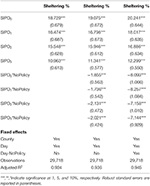
Tabular array 5. Sheltering percentages all Texas counties.
4. Conclusion and Discussion
We analyze both state and county-level effects of the SIPO on the growth of cases and deaths. We discover that growth and death rates are lower during the SIPO period. Nosotros also see that a significantly larger percentage of the population stays at home during this period. Thus, it is non surprising to see that the disease slows down in the menstruation of the SIPO. The more interesting question is whether the SIPO caused stay at home percentages to increase. We find two pieces of show that goes confronting such causality. Offset, even though the highest sheltering corresponds to the offset week of the SIPO, sheltering percentages steadily declined even though the policy was in effect (Figures 2, 3). This pattern might be very much a behavioral response to the emergence and the initial rapid spread of the disease. The fact that people start to see cases in their communities may create fright, and people answer past staying at habitation. Nonetheless, as the duration of home stay gets longer, people might develop fatigue and start moving once more. Second, we make use of the fact that some counties adopted local "safer at home" policies several days before the state-broad blanket policy. The sheltering percentages in these counties started to increase before the state-wide SIPO. However, we see a similar upward trend, albeit at a slower rate, in counties where at that place were no such policies. Also, nosotros practise not observe that these groups of counties converge to a similar sheltering percentage after the state-wide blanket policy. Instead, the counties without whatsoever policy (less populated counties with slower growth of cases) have a lower charge per unit of sheltering than the other counties. There seems to be a gap in terms of sheltering percentages, and information technology persists during besides as subsequently the policy catamenia (Figure iv).
Our analyses testify that the growth charge per unit of COVID-19 cases and deaths decreases when a larger share of the population exercises social distancing past staying at home. However, we do not observe evidence that the state-broad shelter-in-place order increased the percentage of the population that stays at home. The initial local atmospheric condition and county policies may have already encouraged people to stay at abode. It may be a meliorate strategy to reach out to the population and inform them about the current land of disease in their localities. On the other manus, policymakers also need to consider the fact that people may not be able to stay at abode even if they desire to if their employers ask them to go back to work in the absence of such policies. What we advise is that imposing restrictive policies alone may not be plenty to guarantee that people volition exercise social distancing. Thus, such policies must take local conditions into account and exist accompanied by the effort to inform and educate the public about the potential consequences of the disease and the situation in their communities.
Even though the current written report has interesting policy implications, it has limitations. In item, the results may not need to generalize to other states or countries. A similar evolution of the pandemic and like policy rules may generate quite different behavioral responses from the public elsewhere. More local-level studies may exist needed to check the generalizability of our conclusions.
Information Availability Statement
Publicly available datasets were analyzed in this study. This data tin be found here: https://covid19.unfolded.ai/, https://world wide web.naco.org/covid19/topic/research-data.
Author Contributions
All authors listed have fabricated a substantial, direct and intellectual contribution to the work, and approved it for publication.
Conflict of Interest
The authors declare that the inquiry was conducted in the absenteeism of any commercial or financial relationships that could be construed as a potential disharmonize of involvement.
Footnotes
1. ^Centers for Disease Control and Prevention, (CDC) : https://world wide web.cdc.gov/coronavirus/2019-ncov/faq.html#Spread.
2. ^Social distancing, as well chosen "physical distancing" is divers past the CDC equally keeping a condom space (at least vi feet) between yourself and other people who are not from your household.
3. ^The information are consistent with the count of cases and fatalities from the CDC and John Hopkins University.
4. ^Several studies rely on SafeGraph for social distancing measures. See (3, 14–17) among many others.
5. ^The continuous-time version yields similar conclusions. Nosotros stick to the detached version for expositional simplicity.
six. ^According to the Earth Health Arrangement, the incubation flow for COVID-19, which is the fourth dimension between exposure to the virus (becoming infected) and symptom onset, is on average 5–6 days, however, can be up to 14 days: https://world wide web.who.int/docs/default-source/coronaviruse/state of affairs-reports/20200402-sitrep-73-covid-xix.pdf?sfvrsn=5ae25bc7_6#:~:text=.
7. ^Conditions conditions also affect the sheltering percentages. More people are probable to stay at home during rainy or cold days than on sunny days. Notwithstanding, nosotros are mainly interested in the effect of the SIPO on sheltering. As long every bit the conditions is not correlated with the enactment of the policy, our estimates would still exist unbiased (18).
8. ^The fit of the regression (R2) is largest with xiii–15 days lags, and we use 14 days.
9. ^The Appendix shows we get similar results with county-level panel data.
ten. ^Harris county alleged public wellness emergency on March 11, and stay at home order on March 24, which is 9 days prior to the state-broad policy. Similarly, Dallas county declared an emergency on March 12 and ordered residents to stay at dwelling on March 23. Tarrant county's emergency declaration is on March thirteen, and the county-level SIPO date is March 24. Bexar county'south declarations were on March xiii and March 23, respectively. For Travis county, the dates are March 17 and March 24, respectively.
References
3. Dave D, Friedson AI, Matsuzawa Grand, Sabia JJ. When do shelter-in-identify orders fight COVID-19 best? Policy heterogeneity across states and adoption fourth dimension. Econ Inq. (2020). doi: ten.1111/ecin.12944. [Epub ahead of print].
PubMed Abstract | CrossRef Total Text | Google Scholar
four. Killgore WDS, Cloonan SA, Taylor, EC, Dailey NS. Loneliness: a signature mental health concern in the era of COVID-xix. Psychiatry Res. (2020) 290:113117. doi: x.1016/j.psychres.2020.113117
PubMed Abstract | CrossRef Full Text | Google Scholar
five. Smith ML, Steinman LE, Casey EA. Combatting social isolation amidst older adults in a time of physical distancing: the COVID-19 social connectivity paradox. Front. Public Health. (2020) 8:403. doi: x.3389/fpubh.2020.00403
PubMed Abstruse | CrossRef Full Text | Google Scholar
7. Stoker S, McDaniel D, Crean T, Maddox J, Jawanda G, Krentz N, et al. Result of shelter-in-place orders and the COVID-nineteen pandemic on orthopaedic trauma at a community level Ii trauma middle. J Orthop Trauma. (2020) 34:e336–42. doi: 10.1097/BOT.0000000000001860
CrossRef Full Text | Google Scholar
8. Bullinger LR, Carr JB, Packham A. "COVID-19 and criminal offense: effects of stay-at-dwelling orders on domestic violence," in NBER Working Newspaper 27667. Cambridge, MA (2020).
Google Scholar
nine. Froimson JR, Bryan DS, Bryan AF, Zakrison TL. COVID-xix, domicile confinement, and the fallacy of "safest at habitation". Am J Public Health. (2020) 110:960–i. doi: x.2105/AJPH.2020.305725
CrossRef Total Text | Google Scholar
x. Kofman YB, Garfin DR. Dwelling is not e'er a Haven; The domestic violence crisis amid the COVID-nineteen pandemic. Psychol Trauma Theory Res Pract Policy. (2020) 12:S199–201. doi: x.1037/tra0000866
PubMed Abstract | CrossRef Total Text | Google Scholar
12. Wei L, Wehby GL. Shelter-in-Place orders reduced COVID-19 mortality and reduced the rate of growth in hospitalizations. Health Aff. (2020) 39:1615–23. doi: 10.1377/hlthaff.2020.00719
CrossRef Full Text
13. Courtemanche C, Garuccio G, Le A, Pinkston J, Yelowitz A. Strong social distancing measures in the United states reduced the COVID-19 growth rate. Health Affairs. (2020) 39:1237–46. doi: 10.1377/hlthaff.2020.00608
PubMed Abstract | CrossRef Total Text
16. Weill JA, Stigler M, Deschenes O, Springborn MR. Social distancing responses to COVID-19 emergency declarations strongly differentiated by income. Proc Natl Acad Sci United states. (2020) 117:19658–sixty. doi: x.1073/pnas.2009412117
PubMed Abstract | CrossRef Full Text | Google Scholar
17. Woody Due south, Garcia Tec M, Dahan One thousand, Gaither K, Lachmann 1000, Flim-flam S, et al. Projections for showtime-wave COVID-nineteen deaths across the US using social-distancing measures derived from mobile phones. medRxiv. (2020). doi: 10.1101/2020.04.sixteen.20068163
CrossRef Total Text | Google Scholar
eighteen. Wooldridge JM. Introductory Econometrics: A Modern Approach. 6th ed. Cengage Learning (2016).
Appendix
Including all of the 254 Texas counties, we estimate the following regression:
where y i,t is the growth rate of cases and fatalities in county i at time t. We control for time and county stock-still effects, and we cluster standard errors at the county-level. All estimations are weighted by county population.
Time captures days afterward the starting time case rather than agenda days. This way, we are comparing counties at the aforementioned point in the development of the disease'due south spread. If the spread of the disease were strictly exponential, this choice would non matter since the growth rate of cases would be the same regardless of whether a county has a few cases or many cases. Since nosotros know the strict exponentiality is non realistic, our choice provides amend estimates. The results in Table A1 shows that the growth rate of cases is 0.053–0.079 points lower during the SIPO menstruation. The growth rates of fatalities are 0.032–0.058 point lower.
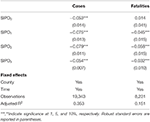
Table A1. The growth of COVID 19 cases and fatalities.
Adjacent, we wait at the relation between the percentage of the population that stays at home in each county and the state-broad shelter-in-place order. We guess Equation (A1) where y i, t is the percent of sheltering population. We command for county and time fixed-effects, cluster standard errors at the county level, and weight regressions by the counties' populations. The outset column in Table A2 shows that the sheltering is 12.four per centum points (nigh 50%) higher in the first of the SIPO flow. Even though the sheltering percentages are statistically larger in the following weeks as well, the margin decreases gradually. Nosotros also include dummies for i and 2 weeks before the SIPO to see how sheltering percentages await earlier the policy. The last two cavalcade reveals that the up tendency in sheltering percentages started fifty-fifty before the policy.
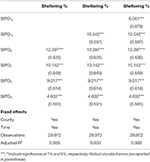
Table A2. Sheltering percentages and the SIPO.
The SIPO is expected to slow down the spread of the disease by increasing social distancing in the population. So, we expect it to influence the spread of affliction via its outcome on the number of people sheltering in place. Due to the nature of the disease, a alter in sheltering behavior impacts the spread of the affliction with a lag. We estimate Equation (A1) controlling for the sheltering percentage xiv days prior. The contained variable y i,t is the growth rate of cases or deaths. We include county and time dummies, and weigh regressions by county populations. Table A3 shows past sheltering percentages are statistically significant determinants of the current growth of cases and fatalities, while the SIPO dummies are no longer statistically meaning.
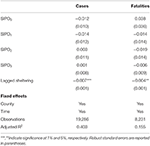
Tabular array A3. The Growth rates controlling for lagged sheltering percentages.
Source: https://www.frontiersin.org/articles/10.3389/fpubh.2020.596607/full
0 Response to "Will We Shelter in Place Again"
Post a Comment